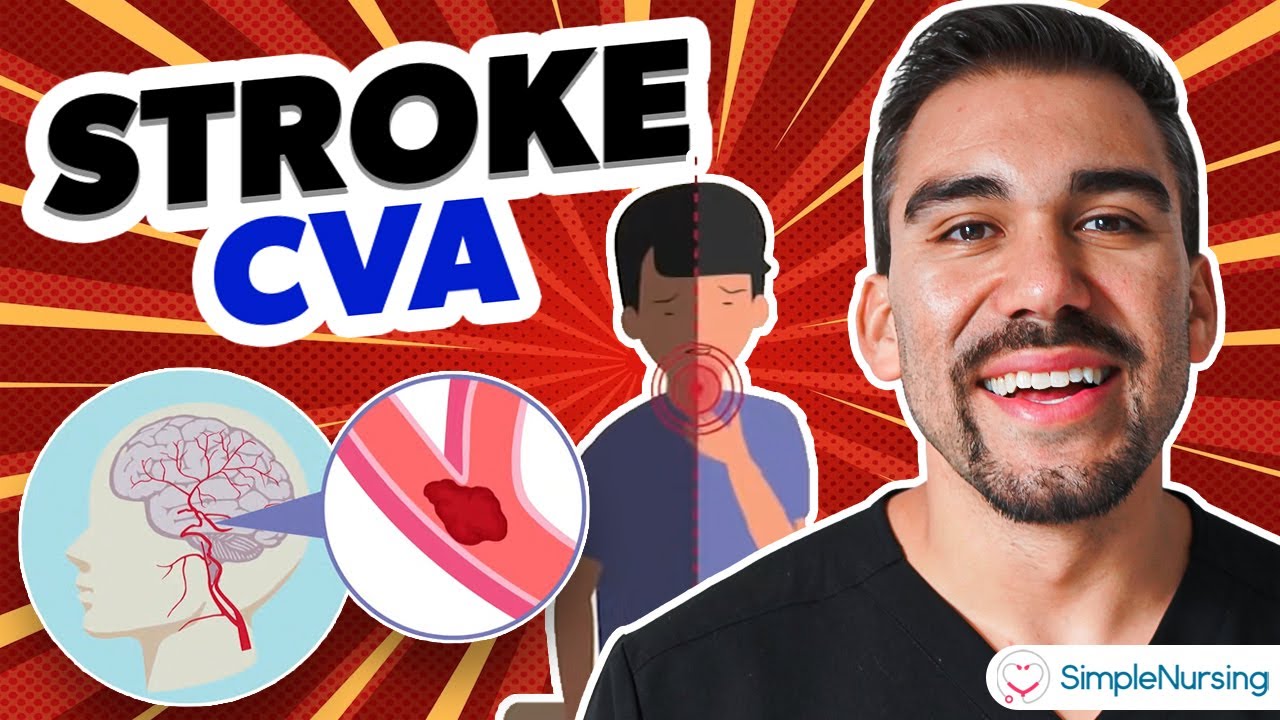Brain Stroke, Types of, Causes, Pathology, Symptoms, Treatment and Prevention, Animation.
Summary
TLDRThis script explains the critical nature of strokes, detailing how they occur due to blood supply disruptions in the brain. It distinguishes between ischemic strokes, caused by blocked arteries often from blood clots, and hemorrhagic strokes, resulting from artery ruptures. The script outlines symptoms, emphasizing the urgency of identifying stroke type for appropriate treatment, whether clot removal for ischemic or bleeding control for hemorrhagic. It also touches on preventive measures, including cholesterol plaque removal and aneurysm procedures, to reduce stroke risk.
Takeaways
- 🚑 A stroke is a medical emergency caused by reduced or interrupted blood supply to the brain, leading to cell death due to lack of oxygen and nutrients.
- 🔍 There are two main types of strokes: Ischemic, caused by a blocked artery, and Hemorrhagic, caused by a ruptured artery.
- 🩸 Ischemic stroke often occurs when a blood clot obstructs an artery, which can be due to fatty deposits or cholesterol plaques rupturing within the artery or from clots traveling from other parts of the body.
- 💔 Hemorrhagic stroke happens when an artery leaks or ruptures, potentially due to high blood pressure, misuse of blood-thinning drugs, or abnormal blood vessel formations like aneurysms and AVMs.
- 🧠 Stroke symptoms can include facial, arm, or leg paralysis, slurred speech, sudden severe headache, vomiting, dizziness, or reduced consciousness.
- 🏥 Immediate medical attention is crucial for stroke as treatment differs based on whether it is ischemic or hemorrhagic, with incorrect treatment potentially worsening the condition.
- 💊 For ischemic strokes, emergency treatment may involve medication like aspirin and TPA to restore blood flow, or mechanical clot removal through a catheter.
- 🩺 Hemorrhagic stroke treatment focuses on stopping the bleeding, reducing blood pressure, and preventing complications like vasospasm and seizures, sometimes requiring surgery.
- 🛡️ Preventive treatments for strokes include procedures to remove cholesterol plaques, widen narrowed arteries, prevent aneurysm rupture, and address vascular malformations.
- 🔧 Interventions like balloon widening and stenting of carotid arteries, as well as clipping and embolization for aneurysms, are part of preventive stroke strategies.
- 🔄 Bypassing problematic arteries is another method to prevent strokes by rerouting blood flow away from areas at risk of clot formation or rupture.
Q & A
What is a stroke and why does it occur?
-A stroke occurs when the blood supply to a part of the brain is reduced or interrupted, depriving brain cells of oxygen and nutrients, leading to their dysfunction and eventual death.
What are the two major types of strokes?
-The two major types of strokes are Ischemic stroke, caused by a blocked artery, and Hemorrhagic stroke, caused by a ruptured artery.
How does an Ischemic stroke occur?
-An Ischemic stroke happens when a blood clot obstructs an artery, often due to the rupture of fatty deposits or cholesterol plaques within the artery, or when a clot from elsewhere in the body travels to the brain, commonly seen in patients with atrial fibrillation.
What causes a Hemorrhagic stroke?
-A Hemorrhagic stroke occurs when an artery leaks or ruptures, which can be due to high blood pressure, overuse of blood-thinning or anticoagulant drugs, or abnormal formations of blood vessels such as aneurysms and AVMs.
Why is it important to differentiate between ischemic and hemorrhagic strokes before treatment?
-Differentiation is crucial because certain treatments for ischemic strokes, such as blood thinners, can critically aggravate bleeding in hemorrhagic strokes.
What are some common symptoms of a stroke?
-Common stroke symptoms include paralysis of facial muscles, arms, or legs, slurred speech, inability to understand simple speech, sudden severe headache, vomiting, dizziness, or reduced consciousness.
What is the initial emergency treatment for Ischemic strokes?
-The initial emergency treatment for Ischemic strokes aims to restore blood flow by removing blood clots, using medications like aspirin and tissue plasminogen activator (TPA), or mechanical devices delivered through a catheter.
How is hemorrhagic stroke treated in an emergency?
-Emergency treatment for hemorrhagic strokes aims to stop bleeding, reduce blood pressure, and prevent vasospasm and seizures, often using a variety of drugs, and possibly surgery to drain blood and reduce intracranial pressure.
What are some preventive treatments for strokes?
-Preventive treatments include removal of cholesterol plaques in carotid arteries, widening of narrowed arteries with a balloon and stent, procedures to prevent aneurysm rupture, removal or embolization of vascular malformations, and bypassing problematic arteries.
What is atrial fibrillation and how is it related to strokes?
-Atrial fibrillation is a heart condition where the heart does not pump blood properly, leading to blood stagnation and facilitating blood clotting. Clots can then pass into the bloodstream and potentially cause an Ischemic stroke by blocking brain arteries.
What is the role of TPA in treating strokes?
-TPA, or tissue plasminogen activator, is a medication used to treat Ischemic strokes by breaking down blood clots. It can be administered intravenously or directly to the brain via a catheter if symptoms have advanced.
Outlines

Cette section est réservée aux utilisateurs payants. Améliorez votre compte pour accéder à cette section.
Améliorer maintenantMindmap

Cette section est réservée aux utilisateurs payants. Améliorez votre compte pour accéder à cette section.
Améliorer maintenantKeywords

Cette section est réservée aux utilisateurs payants. Améliorez votre compte pour accéder à cette section.
Améliorer maintenantHighlights

Cette section est réservée aux utilisateurs payants. Améliorez votre compte pour accéder à cette section.
Améliorer maintenantTranscripts

Cette section est réservée aux utilisateurs payants. Améliorez votre compte pour accéder à cette section.
Améliorer maintenantVoir Plus de Vidéos Connexes

Stroke CVA (Cerebrovascular Accident) Hemorrhagic, Ischemic NCLEX RN & LPN NURSING

C Fenomena dan Keterkaitan Sistem Saraf dengan Sistem Gerak Manusia

Blood supply to the brain

What happens during a stroke? - Vaibhav Goswami

Ischemic Stroke - causes, symptoms, diagnosis, treatment, pathology

What Causes a Stroke?
5.0 / 5 (0 votes)
